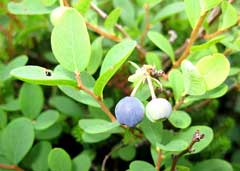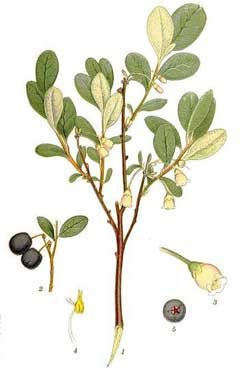 |
|
commons.wikimedia.org/wiki/User:Qwert1234 |
 |
| commons.wikimedia.org/wiki/User:Qwert1234 |
Translate this page:
Summary
Physical Characteristics

 Vaccinium uliginosum is a deciduous Shrub growing to 0.8 m (2ft 7in).
Vaccinium uliginosum is a deciduous Shrub growing to 0.8 m (2ft 7in).
See above for USDA hardiness. It is hardy to UK zone 2. The species is hermaphrodite (has both male and female organs) and is pollinated by Insects.
Suitable for: light (sandy) and medium (loamy) soils and prefers well-drained soil. Suitable pH: mildly acid soils and can grow in very acid soils.
It can grow in semi-shade (light woodland) or no shade. It prefers moist or wet soil.
UK Hardiness Map
US Hardiness Map
Synonyms
Plant Habitats
Bog Garden; Cultivated Beds;
Edible Uses
Edible Parts: Fruit
Edible Uses: Tea
Fruit - raw or cooked[1, 3, 13, 257]. Juicy and sweet[11]. The fruit can also be dried and used like raisins[62]. A reasonable source of vitamin C[257]. The fruit is about 6mm in diameter[200]. Some caution is advised, see the notes above on toxicity. A tea is made from the leaves and dried fruits[101].
References More on Edible Uses
Medicinal Uses
Plants For A Future can not take any responsibility for any adverse effects from the use of plants. Always seek advice from a professional before using a plant medicinally.
Antidiarrhoeal Antiseptic Astringent Birthing aid Carminative Hypnotic Hypoglycaemic Vitamin C
Antiseptic, astringent, carminative, hypnotic and hypoglycaemic[172, 192]. An infusion of the leaves and sugar have been given to a mother a few days after childbirth in order to help her regain her strength[257].
References More on Medicinal Uses
The Bookshop: Edible Plant Books
Our Latest books on Perennial Plants For Food Forests and Permaculture Gardens in paperback or digital formats.

Edible Tropical Plants
Food Forest Plants for Hotter Conditions: 250+ Plants For Tropical Food Forests & Permaculture Gardens.
More

Edible Temperate Plants
Plants for Your Food Forest: 500 Plants for Temperate Food Forests & Permaculture Gardens.
More

More Books
PFAF have eight books available in paperback and digital formats. Browse the shop for more information.
Shop Now
Other Uses
References More on Other Uses
Cultivation details
Requires a moist or wet lime free soil, preferring one that is rich in peat or a light loamy soil with added leaf-mould[11, 200]. Prefers a very acid soil with a pH in the range of 4.5 to 6, plants soon become chlorotic when lime is present. Grows well in a bog garden[3]. Succeeds in full sun or light shade though it fruits better in a sunny position[200]. Requires shelter from strong winds[200]. Dislikes root disturbance, plants are best grown in pots until being planted out in their permanent positions[200]. This species is closely allied to V. myrtillus[182]. Plants in this genus are notably resistant to honey fungus[200].
References Carbon Farming Information and Carbon Sequestration Information
Temperature Converter
Type a value in the Celsius field to convert the value to Fahrenheit:
Fahrenheit:
The PFAF Bookshop
Plants For A Future have a number of books available in paperback and digital form. Book titles include Edible Plants, Edible Perennials, Edible Trees,Edible Shrubs, Woodland Gardening, and Temperate Food Forest Plants. Our new book is Food Forest Plants For Hotter Conditions (Tropical and Sub-Tropical).
Shop Now
Plant Propagation
Seed - sow late winter in a greenhouse in a lime-free potting mix and only just cover the seed[78]. Stored seed might require a period of up to 3 months cold stratification[113]. Another report says that it is best to sow the seed in a greenhouse as soon as it is ripe[200]. Once they are about 5cm tall, prick the seedlings out into individual pots and grow them on in a lightly shaded position in the greenhouse for at least their first winter. Plant them out into their permanent positions in late spring or early summer, after the last expected frosts. Cuttings of half-ripe wood, 5 - 8cm with a heel, August in a frame[78]. Slow and difficult. Layering in late summer or early autumn[78]. Another report says that spring is the best time to layer[200]. Takes 18 months[78]. Division of suckers in spring or early autumn[113].
Other Names
If available other names are mentioned here
Bog blueberry, Whortleberry, Moorberry, Alpine blueberry, Pijanica, Sinikas, Sinya borovinka,
Native Range
TEMPERATE ASIA: Turkey (north), Armenia, Azerbaijan, Georgia, Russian Federation-Western Siberia (Western Siberia), Russian Federation-Eastern Siberia (Eastern Siberia), Mongolia, Russian Federation-Far East (Far East), China (Heilongjiang Sheng (north), Jilin Sheng (south), Nei Mongol Zizhiqu (northeast)), Korea, Japan (Hokkaidô, Honshu (central & north)) NORTHERN AMERICA: Canada (Northwest Territories, Yukon, Québec, Nova Scotia, Ontario, Prince Edward Island, New Brunswick, Newfoundland and Labrador, Saskatchewan, Alberta, Manitoba, British Columbia, Nunavut), Greenland, St. Pierre and Miquelon, United States (Alaska, Maine, Michigan (north), New Hampshire (north), New York (north), Vermont (north), Minnesota, Idaho, Montana, Oregon, Washington, Wyoming (west), California (north), Nevada, Utah (north)) EUROPE: Denmark, Finland, United Kingdom, Iceland, Norway, Sweden, Austria, Belgium, Switzerland, Germany, Netherlands, Poland, Russian Federation (European part), Belarus, Estonia, Lithuania, Latvia, Ukraine, Albania, Bulgaria, Croatia, Italy, North Macedonia, Romania, Serbia, Slovenia, Spain, France
Weed Potential
Right plant wrong place. We are currently updating this section.
Please note that a plant may be invasive in one area but may not in your area so it's worth checking.
Conservation Status
IUCN Red List of Threatened Plants Status :

Growth: S = slow M = medium F = fast. Soil: L = light (sandy) M = medium H = heavy (clay). pH: A = acid N = neutral B = basic (alkaline). Shade: F = full shade S = semi-shade N = no shade. Moisture: D = dry M = Moist We = wet Wa = water.
Now available:
Food Forest Plants for Mediterranean Conditions
350+ Perennial Plants For Mediterranean and Drier Food Forests and Permaculture Gardens.
[Paperback and eBook]
This is the third in Plants For A Future's series of plant guides for food forests tailored to
specific climate zones. Following volumes on temperate and tropical ecosystems, this book focuses
on species suited to Mediterranean conditions—regions with hot, dry summers and cool, wet winters,
often facing the added challenge of climate change.
Read More
Expert comment
Author
L.
Botanical References
1117200
Links / References
For a list of references used on this page please go here
Readers comment
© 2010, Plants For A Future. Plants For A Future is a charitable company limited by guarantee, registered in England and Wales. Charity No. 1057719, Company No. 3204567.